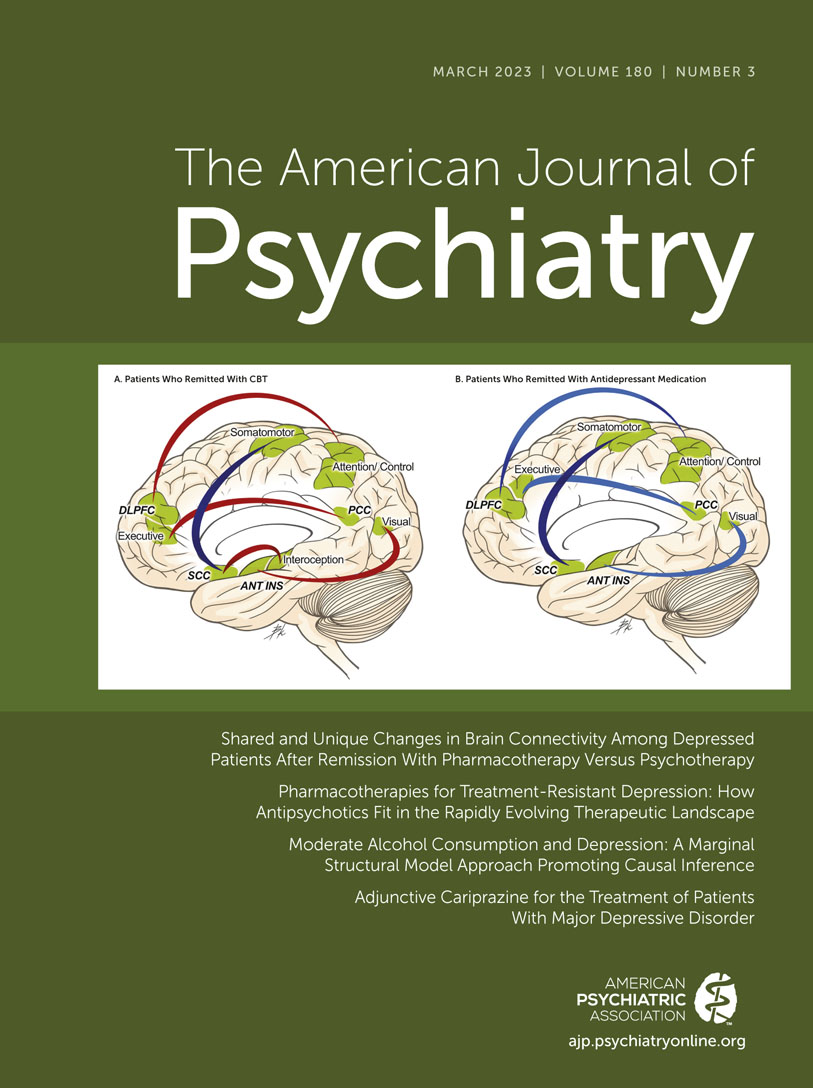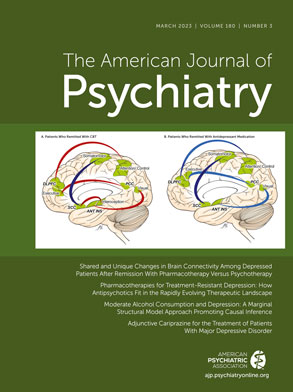Recent approvals by the FDA of dextromethorphan-bupropion combination (where inhibition of CYP2D6 by bupropion increases the bioavailability of dextromethorphan) for treatment of MDD (
89) and brexanolone for postpartum depression (
90) represent examples of drugs with non-monoaminergic mechanisms that possess antidepressant properties. Phase 2 clinical trials suggest efficacy of inhaled nitrous oxide (
91) and MIJ821, a novel NMDA receptor subtype antagonist (
92), for TRD. Esmethadone (an NMDA receptor antagonist) and seltorexant (an orexin-2 receptor antagonist) are two examples of novel-mechanism compounds that demonstrated superiority over placebo in phase 2 studies as augmentation agents in individuals with MDD who experienced inadequate response to one to three antidepressants of adequate dosage and duration in their current episode (
93,
94). Drugs targeting kappa opioid receptors represent another potential novel mechanism as adjunctive treatment after inadequate response to antidepressant medications (
95,
96). Pimavanserin, an antipsychotic medication that is approved by the FDA for Parkinson’s disease psychosis, demonstrated initial efficacy compared with placebo as an augmentation agent in patients with MDD who had inadequate response to one or two antidepressants of adequate dosage and duration in the current episode (
97). However, two subsequent phase 3 trials did not find any significant difference between augmentation with pimavanserin and placebo (
98). While an initial study suggested targeting inflammation as a novel treatment for patients with TRD (
99), subsequent trials of drugs targeting inflammation, including minocycline (
100) and sirukumab (NCT02473289), did not demonstrate any significant difference compared with placebo. Despite antidepressant effects of ketamine, esketamine, and dextromethorphan-bupropion combination, there is more limited evidence for antidepressant effects of other modulators for glutamate receptors (
70). According to sponsor reports, two phase 3 trials of esmethadone (as monotherapy and as an augmentation agent) did not attain their primary outcome of significant reduction in depression symptoms compared with placebo (
101,
102). Lanicemine, a parenterally administered low-trapping NMDA channel blocker, did not significantly improve depression compared with placebo in a large study (N=302) of individuals with MDD with a history of inadequate response to three or more antidepressants (including one antidepressant in the current depressive episode) (
103). Rapastinel, another parenterally administered NMDA receptor modulator with glycine-site partial agonist properties (
104), was evaluated in a large phase 3 program as adjunctive treatment and did not differ significantly from placebo (acute-phase studies: NCT02932943, N=457; NCT02943564, N=658; and NCT02943577, N=429; relapse prevention study: NCT02951988, N=604).
Psychedelic drugs that act as agonists of 5-HT
2A receptors have emerged as novel treatment options for patients with TRD. In an initial open-label study of patients with TRD (N=20) who received two sessions of psilocybin (10 mg and 25 mg, 7 days apart, plus psychological support), there was significant improvement in depressive symptoms that persisted for 6 months (
105). A randomized waiting-list-controlled trial of two sessions of psilocybin (20 mg/70 kg and 30 mg/70 kg, 7 days apart, plus supportive psychotherapy) also found significant improvement in individuals with MDD (
106). A subsequent double-blind RCT (N=59) compared psilocybin at 25 mg (two sessions administered 3 weeks apart) plus daily placebo pills for 6 weeks versus psilocybin at 1 mg (two sessions administered 3 weeks apart) plus escitalopram (10 mg/day for 3 weeks followed by 20 mg/day for the next 3 weeks) in patients with TRD. The two treatment arms did not differ significantly in the primary outcome of reduction in self-reported depressive symptoms (
107). However, rates of remission were higher with psilocybin at 25 mg (57%) than with psilocybin at 1 mg plus escitalopram (28%), with an NNT of 4 (
107). A recent phase 2 double-blind RCT compared a single administration of psilocybin at a dose of 25 mg, 10 mg, or 1 mg (control), along with psychological support in patients with TRD (N=233). Three weeks after the treatment, there was significantly greater improvement in depressive symptoms and higher rates of remission with 25 mg (29%), but not with 10 mg (9%), compared with 1 mg (8%), with an NNT of 5 for psilocybin 25 mg compared with 1 mg (
108). Finally, a small RCT of ayahuasca (N=29), a psychedelic mixture that contains
N,N-dimethyltryptamine and the monoamine oxidase inhibitors harmine and harmaline, in patients with TRD found significantly greater improvement in depressive symptoms compared with placebo, with an NNT of 4 for remission (36% vs. 7%) (
109).

